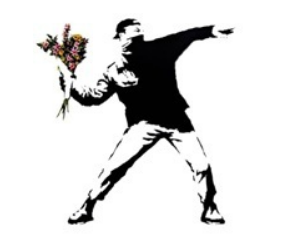Banksy is once again in the media spotlight (has he ever left?). This time for encouraging his fans to shoplift in the Guess fashion store on Regent Street in London. An unconventional IP enforcement strategy that has its explanation.
The store recently infringed Banksy’s copyright to the iconic Flower Thrower by, without permission, printing and displaying the artwork in its storefront window. Hence, freeriding on the awareness and appeal of a Banksy original. As Banksy put it “They’ve helped themselves to my artwork without asking, how can it be wrong for you to do the same to their clothes?”
But, how come Banksy didn’t approach the store with a regular IP cease and desist letter? Rather he entrusted the legal enforcement to his fans. This might of course be considered a new normal in the influencer driven cancel culture we are living in. However, in Banksy’s case there is, from a legal standpoint, an obvious reason why.
Copyright may only be enforced by the rights holder; that is the creator, an assignee or a licensee. A company or another person may claim to have acquired rights to bring actions against infringers. However, in many copyright infringement cases it can ultimately be difficult to prove your rights against a disputing counterparty. This is especially so in the Banksy case considering Banksy’s anonymous way of doing business. Going after copyright infringers the legal way does not seem to be something Banksy is willing to pursue in exchange for his identity. That leaves him on a bumpy road of trying to convince legal institutes of acknowledging anonymous copyright protection.
The hardship of enforcing his copyright might be the reason why Banksy has registered many of his most iconic artworks as EU trademarks, a number of around 15 in total, through the affiliated company Pest Control Office Limited. By doing so, the Banksy administration seems to try to work around the issue of copyright anonymity considering that the rights holder of a registered trademark is the one whose name appears on the certificate. The Flower Thrower artwork is one of these artworks registered as a trademark. So why wasn’t it used against the Guess fashion store on Regent Street in London by Pest Control Office Limited?
Well, the European Union Intellectual Property Office (EUIPO) has taken the approach that the EU trademark system cannot be used as a tool to avoid copyright enforcement concerns by anonymous artists. Even less so when the genuine intention of the registration has never been to use the artwork as a trademark. This bad faith cancellation ground has the past years targeted many of Banksy’s trademark registrations, including a 2014 registration of the Flower Thrower, which was cancelled in 2020. However, it had by then already been filed again as a new registration. Moreover, EUIPO’s standpoint of bad faith was in a October decision by the EUIPO Board of Appeal not accepted and the cancellation decision was rejected. It remains to see whether Banksy’s behavior is ultimately considered as bad faith or good faith by the trademark authorities and courts.
One may question why Banksy is engaged in IP protection and enforcement activities at all. This given his anti-copyright statements in his early career declaring that “Copyright is for losers”. However, it might be that there is a clash within the Banksy administration. A clash somewhat similar to the one dramatized in the Netflix original about Spotify and the early internal battle between the “Pirate Bay thinkalikes” and the more business and IP oriented minds.
Some argue that the IP system allows for anonymous copyright claims, but most do not. Irrespectively, Banksy’s IP endeavor and unconventional IP enforcement actions are amusing to take part in. Especially as an IP specialist dealing with these types of questions on a daily basis.







